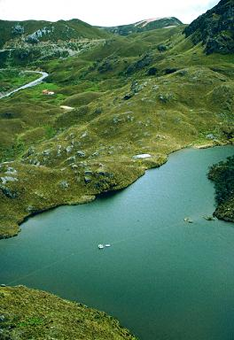NOAA/WDS Paleoclimatology - Ongoke Lake, Alaska 2,000 Year Diatom, Chironomid, and Geochemical Data
This archived Paleoclimatology Study is available from the NOAA National Centers for Environmental Information (NCEI), under the World Data Service (WDS) for Paleoclimatology. The associated NCEI study type is Lake. The data include parameters of paleolimnology with a geographic location of Alaska, United States Of America. The time period coverage is from 1998 to -54 in calendar years before present (BP). See metadata information for parameter and study location details. Please cite this study when using the data.
Dataset Citation
- Cite as: Chipman, M.L.; Clarke, G.H.; Clegg, B.F.; Gregory-Eaves, I.; Hu, F.S. (2008-11-01): NOAA/WDS Paleoclimatology - Ongoke Lake, Alaska 2,000 Year Diatom, Chironomid, and Geochemical Data. [indicate subset used]. NOAA National Centers for Environmental Information. https://doi.org/10.25921/3y03-6842. Accessed [date].
- Please refer to Credit tab for full citation information.
Dataset Identifiers
- doi:10.25921/3y03-6842
- noaa-lake-6194
- NCEI DSI 1200_02
- NCEI DSI 1200_01
ISO 19115-2 Metadata
noaa-lake-6194
| Search Data |
|
| Download Data |
|
| Distribution Formats |
|
| Ordering Instructions | Contact NCEI for other distribution options and instructions. |
| Distributor |
NOAA National Centers for Environmental Information ncei.info@noaa.gov |
| Dataset Point of Contact |
NOAA National Centers for Environmental Information ncei.info@noaa.gov |
| Dataset Point of Contact | Data Center Contact NOAA World Data Service for Paleoclimatology 828-271-4800 paleo@noaa.gov |
| Coverage Description | Date Range: 1998 cal yr BP to -54 cal yr BP; |
| Time Period | -48 to 2004 |
| Spatial Bounding Box Coordinates |
West: -159.416
East: -159.416
South: 59.25
North: 59.25
|
| Spatial Coverage Map |
| General Documentation |
|
| Associated Resources |
|
| Publication Dates |
|
| Data Presentation Form | Digital table - digital representation of facts or figures systematically displayed, especially in columns |
| Dataset Progress Status | Complete - production of the data has been completed |
| Data Update Frequency | Data update frequency not available |
| Supplemental Information | STUDY NOTES: High resolution diatom and chironomid counts and geochemical data (bulk density, LOI, lithics, C/N, biogenic Si) for Ongoke Lake, Alaska, for the past 2000 years. ABSTRACT SUPPLIED BY ORIGINATOR: We analyzed sediments of the past 2000 years from Ongoke Lake, southwest Alaska, for organic carbon, organic nitrogen, biogenic silica (BSi), and diatom assemblages at decadal to centennial resolution to infer limnological changes that may be related to climatic variation in southwestern Alaska. The chronology is based on a 210Pb profile from bulk sediments and nine AMS 14C ages from terrestrial plant macrofossils. Four of the 14C ages span a core depth interval of 60.5 cm but are statistically indistinguishable from one another with a mean of ~1300 AD, which compromises the determination of temporal trends at Ongoke Lake and comparison with other paleoclimate records. The diatom record suggests changes in the duration of ice cover and strength of thermal stratification that are probably related to temperature variation. This variation includes a cold interval around the first millennium cooling (FMC) and a warm interval spanning the medieval climate anomaly (MCA). However, the lake-sediment record shows no clear signals of temperature variation for the period of the Little Ice Age (LIA) or the twentieth century. Climatic changes during these periods may have been manifested through effective-moisture (precipitation minus evapotranspiration) variation in the Ongoke Lake area. We estimate water depths and infer effective-moisture fluctuations by applying a regional transfer function to our diatom record. Together with inferences from diatom autecologies, this water-depth reconstruction suggests that effective moisture increased steadily from 50 BC to 350 AD, which was followed by relatively dry conditions between 550 and 750 AD and relatively wet conditions between 750 and 1450 AD. Effective moisture was low from ~1450 to 1850 AD, coinciding with the LIA; an alternative age model places this interval between ~1315 and 1850 AD. During the past 150 years, effective moisture increased, with estimated water depths reaching peak values in the second half of the twentieth century. This study offers the first paleolimnological record for inferring centennial-scale climatic variation over the past two millennia from southwestern Alaska. |
| Purpose | Records of past climate and environment derived from lake sediment records. Parameter keywords describe what was measured in this dataset. Additional summary information can be found in the abstracts of papers listed in the dataset citations. |
| Dataset Citation |
|
| Cited Authors |
|
| Originators |
|
| Publishers |
|
| Theme keywords |
Global Change Master Directory (GCMD) Science Keywords
|
| Data Center keywords |
Global Change Master Directory (GCMD) Data Center Keywords
|
| Place keywords |
|
| Use Constraints |
|
| Access Constraints |
|
| Fees |
|
Last Modified: 2023-09-05
For questions about the information on this page, please email: ncei.info@noaa.gov
For questions about the information on this page, please email: ncei.info@noaa.gov

